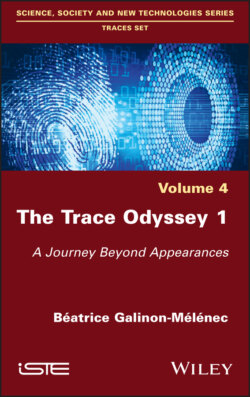Читать книгу The Trace Odyssey 1 - Beatrice Galinon-Melenec - Страница 12
I.6. Distinguishing between “trace anthropocentrée” and “trace ontologique”
ОглавлениеFigure I.1 seeks to remove the ambiguity surrounding the concept of trace and to distinguish the trace identified by human beings, which we call “trace anthropocentrée”, from the “trace ontologique”, which refers to the concept of what human beings do while they don’t have access to an assumed all-existing Real. Even if a person is not omniscient, the individual can nevertheless hypothesize that they result from a chain of conséquences-traces.
We return – in Chapter 4 (Figure 4.4) and Chapter 5’s conclusion (Figure 5.5) – to what this distinction between “trace anthropocentrée” and “trace ontologique” imply; in particular, when (as we see in Figure I.1) it induces the position of the concept of the indice in the anthropocentric sense.
Obviously, this distinction is a debatable hypothesis, insofar as it is a human being who advances it; this hypothesis is thus necessarily anthropocentric. Nevertheless, we believe it is useful for considering the relationship between humans and the way in which they live.
Figure I.1. Distinguishing “trace anthropocentrée” from “trace ontologique”. For a color version of this figure, see www.iste.co.uk/galinonmelenec/traceodyssey.zip
In Figure I.1, the horizontal line separates today’s unobservable Real from an observable reality, which although unobservable is assumed to exist. For “today’s unobservable Real”, we posit the existence of an evolution that produces conséquences-traces that drive researchers to identify other, hypothetical existences. Then, using increasingly complex and efficient equipment, humans develop concepts that evolve in time and space to broaden a scientific understanding of the whole of known reality. In Figure I.1 the dotted line18 indicates that the frontier between a perceived reality and an assumed Real changes each day. In this sense, we see how the Real becomes reality (Galinon-Mélénec 2020).
The part above the horizontal line corresponds to the part observed by humans. As Paul Watzlawick states in How Real is Real19 (Watzlawick 1978), the belief that our perception of reality is the reality, is a dangerous illusion. In fact, each individual understands perceived reality differently. The different resulting representations cannot cover the totality of the Real whose existence is assumed, though not perceived in its entirety by humans.
The Trace Odyssey 1 illustrates this point by explaining that reality is perceived differently by each person according to a “corps-trace” that integrates – among other elements that we develop later – the conséquences-traces of their respective life history. The “corps-trace” induces representations in individuals about the perceived reality20 that do not perfectly overlap with other individuals’. This partial overlap can be explained by taking into account the conditioning openness to the reception of what surrounds individuals, the direction of attention to achieving objectives, and the reference points from the senses, emotions and affects. Given all these different factors, misunderstandings can occur in all communication between speakers, even those of the same language.
